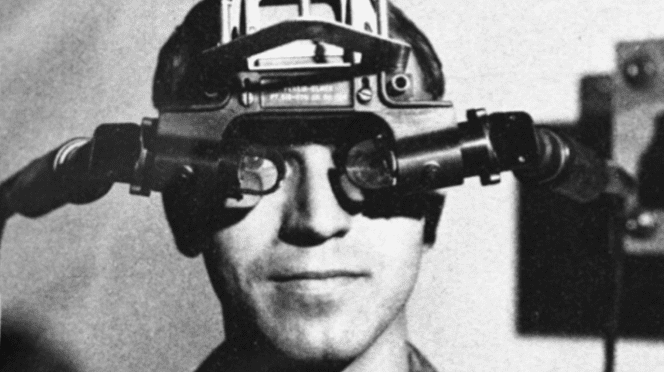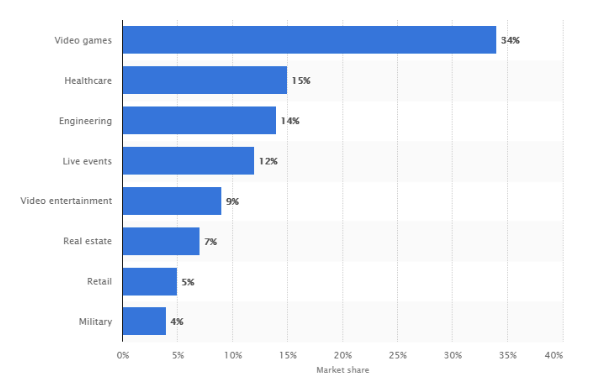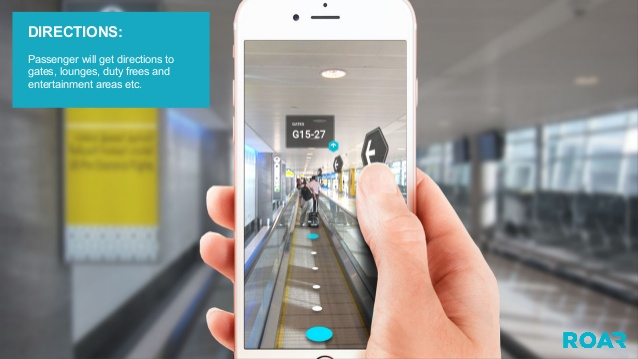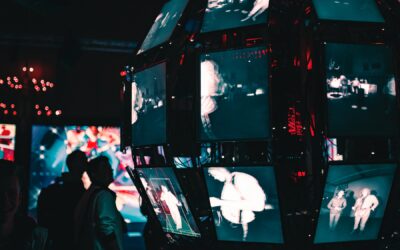Augmented reality (AR) was first conceived as a science-fiction concept to support the creative narrative in films, books and plays. Our imagination took us as far as visualising digitally displayed information in thin-air, yet no one could put this into practice. The technology has come a long way since the conception of its possibilities. We’re no longer confined to the limits of our imagination since augmented reality has become a real-life and widely applicable phenomenon.
The history of augmented reality is a truly remarkable development that has changed the course of how we live, work and play. Across all industries the application of AR has boosted efficiencies, cut costs and generated wide-scale opportunities. From education and healthcare to finance, manufacturing and logistics, AR has disrupted every corner of every industry.

(Augmented reality and virtual reality market 2017 – 2025. Image: Valuates Reports)
The history and development of AR is beginning to pay off with the market forecast to reach $72.8 billion in 2024.
What is Augmented Reality?
Augmented reality essentially adds digital elements such as text, images, videos and audio to a screen. When done effectively, it creates the illusion that the holographic content is part of the physical world around the user. Whilst a similar principle to virtual reality (VR), an AR experience does not immerse a user into an artificial environment. Rather, AR alters a users’ perception of reality by adding three-dimensional objects, sounds, videos and graphics to their view of reality.
Overlaying superimposed digital content onto a screen can be applied in different ways. Consider Snapchat and Instagram filters that change a user’s face into a zebra, cowboy or kitten. Mindlessly opening Google Maps or Waze is a form of interacting with augmented reality. The digital navigation that guides us through streets and across continents is a highly utilised tool.
In order to retrieve and show relevant digital content to users, AR uses computer vision, simultaneous localization, mapping and depth tracking – using sensor data to calculate the distance to objects in the user’s field of vision. For instance, when using a navigation app, computer vision processes the location and objects captured by the camera and recognises it. The program then puts labels onto the surface, and the same process happens each time the user holds the camera in front of the location that has previously been mapped. This is markerless AR.
The same principle is applied in gaming. For example, a football AR app will recognise the player’s foot by setting a virtual footprint on the player’s actual foot and its motion. As such, the player can kick a virtual football down the pitch on the screen and the tech remembers each player’s foot to keep score. Object recognition, therefore, is a key component of AR – but it hasn’t always been readily available.
What’s clear today is that the power of AR is infinite wisdom and application. Let’s take a look at how we got here.
The inception of augmented reality
If augmented reality is ultimately the overlay of human symbols and technologies onto the physical world, the one might be tempted to trace its roots back to 370 BC when Socrates considered writing to be an emerging technology. But that would make for an incredibly long history of which this particular article has little relevance. A more suitable place to begin would be in 1957. This was the year a cinematographer named Morton Heilig invented the Sensorama. This device delivered visuals, sounds and smells to the viewer.

(Ivan Sutherland’s head-mounted display. Image: iGreet)
Needless to say, this wasn’t supported by computer technology but it was undeniably an attempt to add additional data to enhance an experience of the real world. The following decade, in 1968, the world was introduced to the hardware on which AR would come to rely on for much of the 20th century.
Ivan Sutherland, an American computer scientist and internet pioneer invented the head-mounted display that acted as a window into the virtual world. At the time, this technology and the equipment used made the invention practically impossible for mass use.
1975 was a turning point in the history of augmented reality as well as virtual reality. Myron Krueger, an American computer artist developed the first ‘virtual reality’ interface with Videoplace. It enabled users to manipulate and interact with virtual objects and to do so in real-time. Before the end of the decade, Steve Mann gave the world wearable computing in 1980.
Technically, the term “augmented reality” was coined far later, in 1990 by Thomas P Caudell of Boeing. The first successful and properly functioning augmented reality system was developed at USAF Armstrong’s research lab by Louis Rosenberg in 1992. Virtual Fixtures was a complex robotic system designed to offset the lack of hi-speed 3D graphics processing power at the time. It enabled the overlay of sensory data and information on a workspace, through a lens to contribute to human productive capacity.
Mass consumer adoption of augmented reality
The 90s’s saw AR make strides towards mass consumer adoption. The Glow Puck brought genuine AR technology into the homes of hundreds of millions. The Glow Puck essentially made watching hockey more enjoyable for newcomers. Traditionally, watching hockey on the TV is difficult since the puck is so small. The Glow Puck used a proprietary camera trick to leave a bright yellow trail where the puck had traveled. This technology has been embedded elsewhere in broadcast sport until today.
30 years later, the National Hockey League has developed a new embedded microchip solution that debuted at the 2019 NHL All Star Game and is projected to feature in every arena for the 2020-2021 season.
Augmented reality enters the workplace
In 1999, NASA created a hybrid synthetic vision system of their very own X-38 spacecraft. This was the first time NASA had successfully implemented augmented reality. It used an AR mechanism to overlay map data to enhance the visual navigation in the flight testing period. The digital data was displayed right on the pilot’s screen and helped to provide better navigation.

(AR applications across industries. Image: Information Age)
Accessible, real-time data allows for better, faster decisions to be made in the workplace. Whether that’s navigating your way through the sky or pulling up client, patient, or stakeholder data when you need it; augmented reality, since its preliminary use cases has been consistently moving towards improving workplace safety and efficiency.
Augmented reality explodes in the 2000s
Entering the 21st century it was near to impossible to find a futurist vision of technology where augmented reality wasn’t the centre of the idea. According to a 2002 Minority Report, holograms were to be everywhere and gesture controls ranked central to their uses. Its prominence was exacerbated in Hollywood as well as the education sector – where the emerging technology was a key learning field.
AR seemed to have all the answers in the 2000s when it came to entertainment, gaming and learning. Yet, the promise of hands-free, ubiquitous computing raised serious questions of privacy, safety, security and ethical implications. Google, as a first-mover in the AR industry, was overwhelmed with public outrage and mass legislative action when they launched their first generation of Google Glass in 2013.
However, in 2015, Google managed to rise from the ashes and serve a new enterprise target market. Google’s Enterprise Edition is the lightest device of its kind. Until recently, the cost of AR was so substantial that it was outside the budget of most SMEs. Today, AR has evolved into an affordable, portable and multi-applicable technology that is even available on mobile devices. As a result, design of AR content comes in all shapes, sizes and purposes.
AR in 2010 is in everyone’s back pockets
Everyone loves a throwback and when Niantic coupled Pokemon with AR, the results were infectious as more and more players were compelled to get out and catch the digital monsters on their phones. Within a week of its launch, Nintendo’s market capitalization was up $9 billion and the app continued to win more active users in a day than Twitter, Instagram and Google Maps. No game has since risen to such stardom as quickly.
The ubiquity of smart mobile phones around the world made mobile VR accessible to virtually anybody. In 2010, 298 million smartphones were sold globally – up from 175 million in 2009. This 70% growth rate had a direct impact on the future of augmented reality and business in particular.
Companies were beginning to consider the role AR could play in their marketing and customer relationship management. Marxent, an AR software company released its first-ever application of AR on the app store in November 2011. It largely revolved around marketing campaigns and set the way for businesses to find use cases and implement AR and VR on broader scales.
In 2018, Magic Leap released their first-generation headset, Magic Leap One that certainly delivered on its promise to blur the line between the digital and physical worlds. It did so with advanced physics and situationally aware lighting and shading of virtual objects. This technology alone has been particularly successful in creating AR content that captures users’ attention and keeps them engaged.
AR in the 2020s
In summary, in the 2010s, AR was fun. Things get serious when it comes to the development and applications of AR in the 2020s. In fact, in March 2019, it was predicted that mass production of Apple’s first-generation AR headset, powered wirelessly by iPhone would begin to ramp up in Q4 2019. Using history as an indication, when Apple enters the game in any market, competition spikes.
Since Microsoft and Apple have similar market caps, equally vast resources and a long-standing tradition of out-competing one another; the following decade is posed as an arena for the two when it comes to developing immersive hardware to capture more market share.
Lenovo and others aren’t necessarily out of the game. Lenovo, in particular, have demonstrated their unique approach and strength with their Star Wars Jedi Challenges. The combination of such innovative brands in the market guarantees that AR will become lighter, more versatile and less expensive.
AR in the next decade
The opening of the decade maintains AR hardware to be heavy, hot and relatively expensive. Enters Microsoft HoloLens 2 – a significantly more versatile and comfortable headset than what we’ve so far been exposed to. Further, Elon Musk’s Neuralink promises a brain-to-computer interface to be ready for mass adoption in a few years.
Amidst today’s software, devices, and invisible contacts; over the next decade, we’re likely to witness an immersive device so compelling, it will be everywhere and everyone will have one. AR will find itself applying the vast knowledge of science and humanity in a meaningful context.
AR and its applications today
The history of augmented reality has led us to the most innovative and exciting period for emerging technology. The growth of AR applications in recent years is largely attributable to the shift in consumer demands. In other words, along with access to instant information, instant coffee, instant transactions and communications; consumers are increasingly expecting more convenience from the brands they interact with.
AR solutions have enabled consumers to visualise products and imagine what it might feel like to own or use the product or experience it long before actually buying it – all from the comfort of their homes. As AR has become more sophisticated and the cost-saving benefits become more clear to businesses, the demand and investment in AR will increase. In fact, Apple’s ARKit and Google’s ARCore are already powerful tools in place for developers to create AR apps. So what’s happening in the AR-business realm around us today?
Gatwick airport passenger app

(Gatwick Airport Passenger App. Image: Gatwick Airport)
The award-winning app has risen to stardom for its creative use of augmented reality. Gatwick airport installed more than 2,000 beacons throughout its terminals. Passengers can use the AR map from their smartphones to navigate through the airport. It also provides real-time flight updates, gate information and check-in and security queue times straight to the passenger’s device. As the app develops it’s anticipated to eventually help improve traffic flow in the airport too. The aim is to allow holidaymakers and business travelers a seamless experience when travelling through Gatwick.
Try before you buy
Apps like Ikea Place and Dulux Visualiser, have helped consumers to visualise their planned home refurbishments before they commit to buying new furniture or changing the colour of their walls. Ikea Place was built using Apple’s ARKit technology and works by allowing users to scan a room and design the space using Ikea’s digital catalog. Users then have a reimagined, digital image of the new environment they wish to create and can then purchase the items in the app.
The Dulux Visualiser works in a similar way by letting users try out a shade of paint for a room before they buy it. Users simply use their smartphone camera to scan a room and virtually paint it with any shade Dulux offers.
Lowe’s, the home improvement store, introduced Measured By Lowe’s – a virtual tape measure supported by AR technology. When used in combination with Envisioned by the Mine (Lowe’s sister company), users can place 3D images of furniture and accessories into their space.
Similarly, cosmetics company Sephora released an AR app to allow customers to try out their products without setting foot in a store. Users are able to test different shades of makeup across their eyes, lips and cheeks by overlaying digital content on their screen devices.
Rolex has also used AR to inspire customers to make a purchase. The company has developed a virtual try-on experience where customers can try out different models and styles in real-time.
AR in education
Using augmented reality in education across all settings can transform an ordinary learning experience into an engaging and thought-provoking exercise. AR technology supplements digital visual and audio elements to support traditional textbook materials. Research shows that students learn better when they are engaged – retention of information is stronger and the willingness to continue learning is improved.
AR can also inspire empathy in an individual in an education setting. The combination of interactivity and engagement with emotion; plays a significant role in helping students to remember what they’ve learned.
Engaging with AR digital content in the classroom helps students to deepen their knowledge when it comes to several areas including reading numeracy, spatial concepts, content creation, on, and real-life environments.
AR in healthcare
The most obvious use case of AR in healthcare is the instant accessibility of information and data superimposed on a digital screen for training purposes. In other areas, doctors and nurses are able to pull up patients’ information in real-time. But what about when it comes down to the individual who needs to make healthcare decisions?
What would you do if the person next to you suddenly collapsed? You’d probably reach for your phone to call an ambulance. Phone in hand, the Layar reality browser combined with AED4EU app will provide you with basic emergency information wherever you are in the world. AR is getting closer to bringing burial pieces of information closer to those in need and in danger.

(AR in healthcare trend and forecast 2016 – 2023. Image: MedGadget)
The augmented reality market capitalisation in healthcare is forecast to reach $1.32 billion by 2023. We can expect to see a mass increase in the development and application of AR technology across the healthcare industry as the market continues to grow and the costs of implementing AR falls.
The exciting applications for AR in healthcare extend to helping medical students train in AR environments and to telemedicine options that enable medical professionals to interact with patients. By having real-time information on hand – treatment, diagnosis, and surgery plans can be more seamless.
AR-supported AccuVein is a handheld device that scans the vein networks of a patient that leads to a 45% reduction in escalations. Using this tool, surgeons can plan procedures before making the first incision. Further, models can be made of tumors and AR diagnostic tools can model disease conditions.
AR in aviation
In aviation, augmented reality is now one of the more important innovations in bringing safety to the processes. The aviation industry has evolved a lot in terms of safety but there will always be room for improvement. This is, of course, especially true when it comes to pilot errors. According to a survey, around 85% of aviation accidents happen due to an error made by pilots. With the help of AR, commercial flying can be navigated and traffic visualised.
Jet planes all over the world are using AR navigation to fly, target, navigate and complete their mission. The glass screen overlaid with digital content in front of the pilot helps him or her to make correct decisions and keep the jet safe. The same technology is now beginning to be used in the commercial flying industry.
New startups in the AR game are presenting AR navigation systems for commercial pilots. These systems are able to make visualisations more sophisticated to allow for aviation safety.
The application of AR in aircraft maintenance can result in improved efficiencies and safety enhancements. The tech can offer real-time details with a combination of scanning, sensors, and others. With such a comprehensive inspection of the aircraft, maintenance checks are improved.
AR just for fun
As opposed to simply using AR in a business setting, to push sales and increase efficiency; AR has also been created and can therefore be used just for fun. Learning about and exploring new technologies is part of what keeps innovation and development going. Taking some time to experience what AR has to offer is part of what augmented reality is all about.
From gaming to construction to AR in browsers or in digitised print augmented reality apps, software and content are being developed at a rapid pace. This point in time will soon become part of the history of augmented reality. As the tools and technology develop, we should expect to see augmented reality applications revolve around many more aspects of our life.








